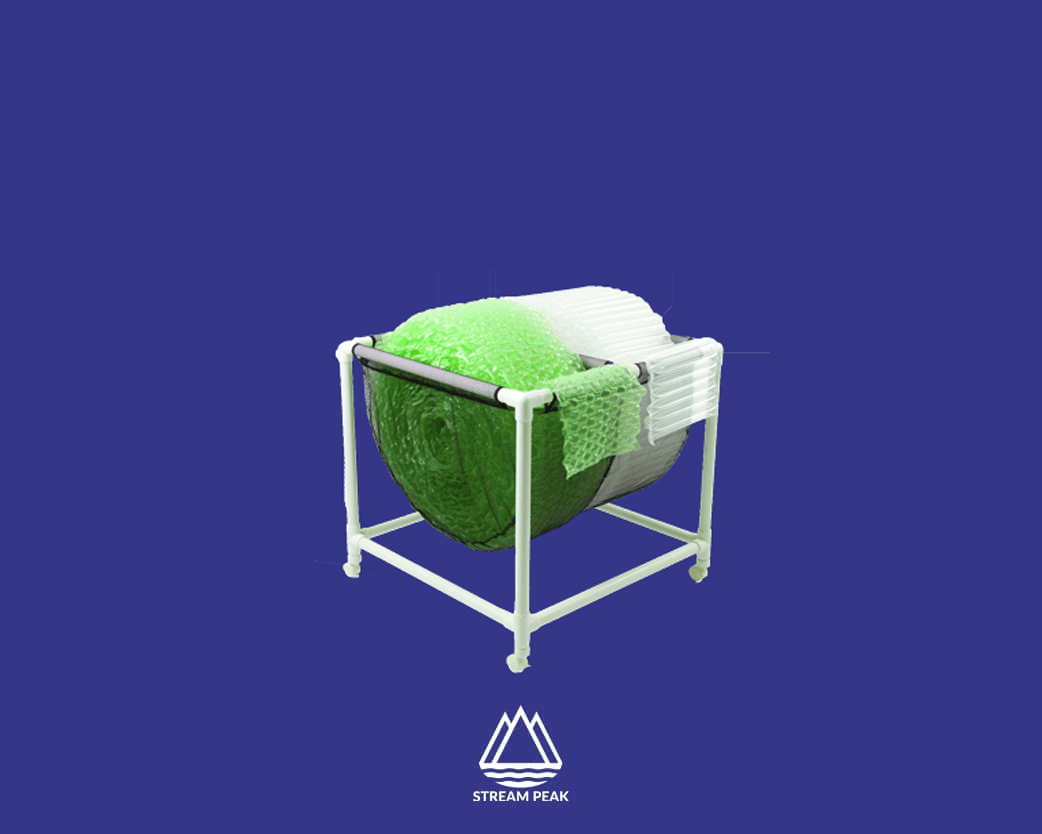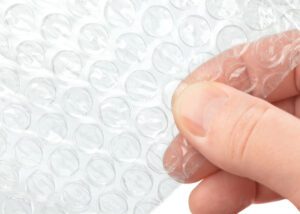What is a Bubble Wrap?

Bubble wrap is a packaging material consisting of small pockets of air enclosed between two layers of plastic film. This arrangement is designed to provide optimal cushioning and protection to items during transportation and storage by effectively absorbing impacts, shocks, and vibrations that could cause damage to delicate items.
The lightweight and durable nature of air bubble packaging has contributed to its increasing popularity among businesses. The air bubble material offers a cost-effective, easy-to-use, and recyclable void-fill solution for packing materials, boxes, or containers with fragile items.
The void-fill packaging material is an effective solution to fill up empty spaces within the packaging, thus preventing products from shifting during transit. Air bubble packaging materials are available in different sizes and shapes, making them highly versatile and suitable for various packaging needs. This enables businesses to select the most appropriate air bubble packaging material to meet requirements.
History of Bubble Wrap
In 1957, two engineers by the names of Alfred Fielding and Marc Chavannes set out to create a three-dimensional plastic wallpaper. However, during experimentation, they invented bubble wrap – a packaging material that has since become iconic and widely used globally. Despite an initially lukewarm reception from consumers, bubble packs gained momentum and, by 1960, had become a preferred choice for packing fragile items.
Over the last six decades, bubble cushioning wraps have become a vital packaging solution for businesses worldwide. They are now extensively used in Singapore as a void-fill packaging solution. The journey from an experiment to a popular and indispensable packaging material underscores the innovation and versatility of bubble wrap.
Types of Bubble Packs
Several different types of bubble wrap are available, each designed to meet specific packaging needs. Standard bubble wrap, with bubble sizes ranging from 3/16 inch to 1 inch, is the most commonly used type. The packaging provides excellent cushioning and protects delicate items such as electronics, glassware, and artwork.
Anti-static bubble wrap is another popular type of bubble wrap that is designed to protect electronic components from static electricity. This bubble wrap type is ideal for shipping electronics as it dissipates the charge before it can cause damage.
Biodegradable bubble wrap is an environmentally-friendly alternative to traditional bubble wrap. Made from recycled materials, it is fully biodegradable and can be composted or recycled after use.
There is also bubble wrap with adhesive backing, which can be used to secure items in place during shipping or storage. This bubble wrap type is ideal for securing smaller items that may shift or move during transport.
In addition, there are speciality bubble wraps such as heavy-duty bubble wrap, which has thicker bubbles and is designed for extra protection, and bubble wrap with foil backing, which provides insulation against temperature changes.
Benefits of Bubble Cushioning for Packaging
Bubble wrap offers numerous benefits, including effective cushioning, shock absorption, and protection for delicate items during transit. The air-filled bubbles act as a barrier between the items and the outside environment, reducing stress during handling and minimising vibrations during shipment.
Air bubble packing presents an ideal solution for businesses seeking to reduce packaging costs without compromising the protection of products. The packaging material is easily storable and transportable, conserving resources and minimising environmental waste. Additionally, the air-filled bubbles offer reliable cushioning, ensuring that items reach their destination in pristine condition.
Bubble films can be effortlessly cut to any desired shape or size, making them versatile and adaptable to different packaging needs. Moreover, the recyclable versions of bubble packs provide businesses with a sustainable option to minimise plastic waste sent to landfills while providing optimal protection during transit. Using bubble wrap machines can efficiently save both cost and space for larger-scale packaging operations.
Protect Against Damage from Rough Handling or Vibration
The air-filled bubbles found in bubble wrap create a protective layer around items, minimising the risk of damage from rough handling or vibration during transit. This feature makes bubble wrap an excellent packaging solution for fragile items such as electronics, glassware, and artwork.
Furthermore, the flexibility of bubble packs allows for the customisation of protection based on the specific needs of each product, ensuring that it arrives at its destination undamaged. It is recommended to use packaging indicators or impact data loggers to detect impact during transportation and further protect the items.
Bubble cushioning wrap is lightweight, requiring minimal material, which reduces shipping costs. Additionally, the air bubbles offer strong cushioning, making it possible to package multiple items together without taking up too much space. The lightweight and compact packaging makes it easy to store and transport, allowing businesses to minimise their environmental footprint and waste.
Bubble packs come in recyclable varieties, which can be reused multiple times, making it a cost-effective and eco-friendly way to protect items during shipping or storage. Some companies also offer buy-back programs to purchase used bubble cushioning wraps from customers, encouraging them to recycle and reuse the packaging material instead of disposing of it. By implementing these initiatives, businesses can reduce packaging costs and contribute to a greener future with sustainable packaging.
How to use bubble packs?
Firstly, working on a clean and flat surface is recommended when preparing goods for shipping. Adequate space should be provided to tape, fold, and safely store delicate items without disturbing other desk items or countertop ornaments.
Ensuring that the bubble side of the sheet face packaging is essential upwards during packaging. By doing so, the air pockets can provide optimal protection for fragile items during shipping, mailing or storage. If the air bubbles face outwards, they are more likely to pop during transit, reducing the degree of protection provided.
When packing delicate items, it is advisable to use adequate bubble wrap to ensure they are well protected. Depending on the size and shape of the goods, extra care may be required to properly secure and protect them from external shock or impact during transport. For example, additional padding may be necessary to provide additional protection when packing fragile items such as glassware or electronics.
Find out more here on how to use bubble wrap.
Conclusion
In conclusion, bubble cushioning wraps are an extremely valuable packaging solution that provides protection and cushioning to delicate items during storage and transportation. Due to its reasonable cost, lightweight property, and convenience, it has become a popular packaging solution for businesses seeking to minimise packaging costs without compromising product safety.



